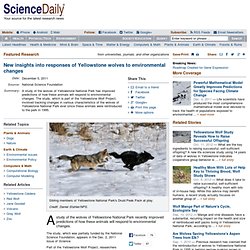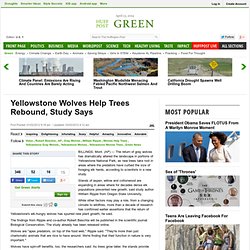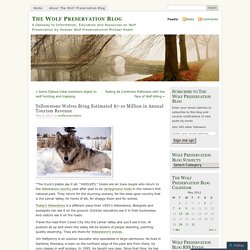

Wolf Report WildEarth Guardians. 2012. Yellowstone Science 13 (1) New insights into responses of Yellowstone wolves to environmental changes. A study of the wolves of Yellowstone National Park recently improved predictions of how these animals will respond to environmental changes.

The study, which was partially funded by the National Science Foundation, appears in the Dec. 2, 2011 issue of Science. Part of the Yellowstone Wolf Project, researchers tracked changes in various characteristics of wolves living in the national park between 1998 and 2009. They found some tracked characteristics--such as population size--are related to population ecology, while other tracked characteristics--such as coat color--are genetically determined through evolution.
The project also involved using a new model to compare data collected on Yellowstone wolf characteristics to environmental conditions through the years covered by the study. Researchers defined conditions in the park during each year of the study along a continuum from "good years" to "bad years"--with good years more favorable to wolf survival than bad years. Yellowstone Wolves Help Trees Rebound, Study Says. BILLINGS, Mont.

(AP) — The return of gray wolves has dramatically altered the landscape in portions of Yellowstone National Park, as new trees take root in areas where the predators have curbed the size of foraging elk herds, according to scientists in a new study. Stands of aspen, willow and cottonwood are expanding in areas where for decades dense elk populations prevented new growth, said study author William Ripple from Oregon State University. While other factors may play a role, from a changing climate to wildfires, more than a decade of research has confirmed earlier assertions that the return of Yellowstone's elk-hungry wolves has spurred new plant growth, he said. The findings from Ripple and co-author Robert Beschta will be published in the scientific journal Biological Conservation. The study already has been released online. Wolves are "apex predators, on top of the food web," Ripple said.
In a 2010 study, U.S. "The question is, how many wolves does it take? " Also on HuffPost: Yellowstone Wolves Bring Estimated $7-10 Million in Annual Tourism Revenue. “The truck’s plates say it all: “4WOLVES.”

Inside are an Iowa couple who return to the Yellowstone country year after year to be campground hosts in the nation’s first national park. They return for the stunning scenery, for the wide open country that is the Lamar Valley, for herds of elk, for shaggy bison and for wolves. Today’s Yellowstone is a different place than 1995′s Yellowstone.
Biologists and ecologists can see it on the ground. Outdoor educators see it in their businesses. Travel the road from Cooke City into the Lamar Valley and you’ll see it too. Jim Halfpenny is an outdoor educator who specializes in large carnivores. “There were fifty-four classes on wolves taught in the first half of 2000 from eleven different organizations. Economically, the story has been extremely bright. Latest Studies On Yellowstone National Park's Wolf Packs Shows Stable Population. Latest research on Yellowstone National Park's wolf packs shows that the largest packs, and some of the largest wolves, roam the interior of the 2.2-million park.

Photos courtesy of Doug Smith, Yellowstone Wolf Project director. Editor's note: Contributing writer Beth Pratt recently caught up with Douglas Smith, who has been studying wolves for more than 30 years and who currently leads the wolf project in Yellowstone National Park. He is the co-author of Decade of the Wolf, a book that details the historic wolf restoration in Yellowstone.
The two talked about the current status of wolves in the park and their impact on elk populations. You are the middle of your annual winter research—what are you finding initially? To a degree, and I guess the message from this trend is “less is more.” I imagine this is more what Yellowstone was like before it got changed because of European humans.
When we start killing predators because we want more animals to hunt, it becomes agriculture.